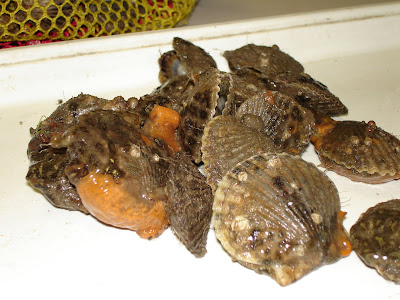
So, no, that picture isn't from my first day of diving this year (which was yesterday). Unfortunately, I didn't bring a camera with me, but we dove on one of our free plant spawner sanctuaries and the above photo is a picture from last October when we planted the scallops. Of course on the day I didn't have a camera, I saw a juvenile hake of some sort as I was moving aside some macroalgae to look for scallops. If I had to guess, I would say it was a
red hake,
Urophycis chuss, but without the camera and a snapshot, I can't say for sure. That may not sound very exciting, but its not something I have seen in the field, only collected in trawls. While counting scallops, I also observed a scallop trying to swim with a oyster drill attached to its shell. It was unable to swim properly, and upon further inspection, the drill had already drilled a clean hole into the shell, which means it was likely attached for a while. There was also a grass shrimp eating some sort of annelid worm. It was funny, because as I dropped my quadrat, I saw this yellowish thing moving around. When I got a closer look, I saw the shrimp holding the worm and the worm was still wriggling around. It reminded me of when I was younger and we kept African clawed frogs in our fishtank and fed them earthworms. The frogs would shove them into their mouths with their front legs and the worms would try to wiggle out. Very entertaining. So, yeah, I wish I had my camera.
But now for the good news. Last fall we planted approximately 170,000 scallops in
Hallock Bay, on the North Fork of Long Island, near Orient Point. The year before, we planted similar densities of scallops in Hallock Bay, but they experienced extremely high over winter mortality, likely due to dense macroalgae and associated low dissolved oxygen under the canopy. We weren't sure what to expect this year, since last spring, we only observed about a 2-3% survival. Last fall we chose a new site, slightly deeper, solid bottom, more current, and less algae cover. Well it seems at first glance like the new site has paid off. By my quadrat counts alone, I would guess that we are seeing between 30-50% survival of the scallops we planted last fall. That exceeds our expectations. Overwinter mortality is usually a large source of natural mortality, however, the scallops are still small - between 28-40mm, so they are not yet above the size threshold for predation. In fact, at the site we observed many cluckers and cracked cluckers, broken shells, and predators including mud crabs and spider crabs. Luckily, the water is already warming up (it was 13.5 C yesterday) so they should start growing. In another planting site we checked, with less water exchange and slightly warmer temperatures (15.5 C), we observed approximately 3-5mm growth on the scallops already (we can tell the new shell growth due to the growth ring laid down during the winter). This bodes well for the scallops planted in Hallock, because they should start growing pretty soon!
On a final note, we went over to my grass mat site. All the buoys were gone, probably because Hallock was covered with ice this winter (in fact, it is a
popular ice boating site). I was concerned with the ice ruining my mats, but on a quick inspection, the grass mats all seemed to be ok. I'll be getting in the water at my site in 2 weeks for a more in depth inspection, as well as to remark my site with new buoys. But so far, so good!








 Some sort of comb jelly (in the bottom of the photo)
Some sort of comb jelly (in the bottom of the photo) And, as always, lots of scallops!!!!
And, as always, lots of scallops!!!!

































